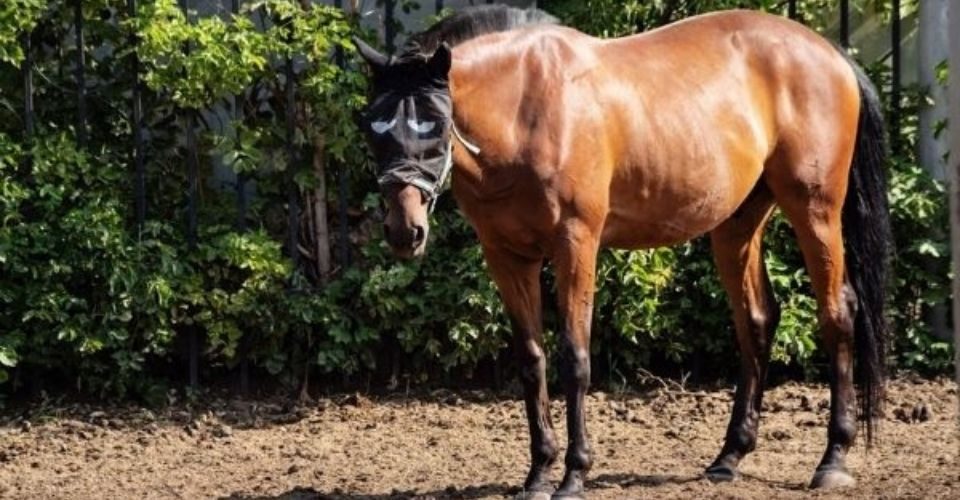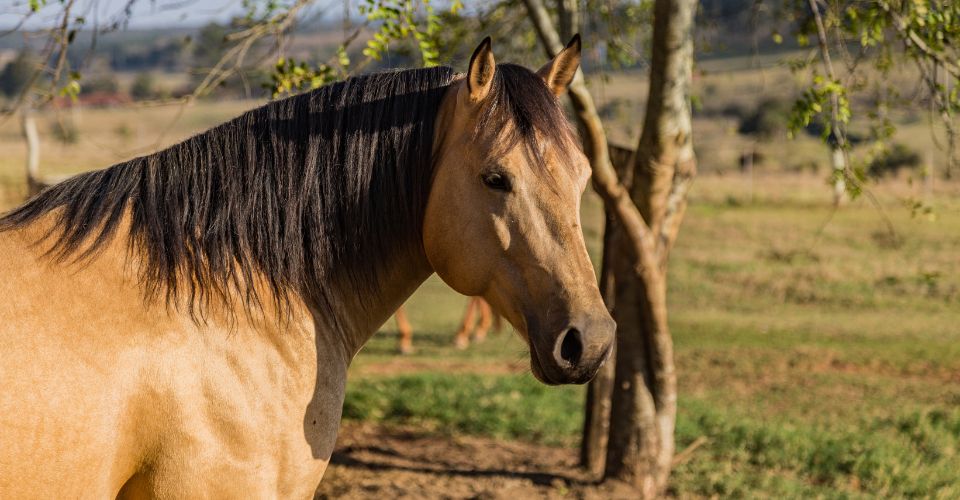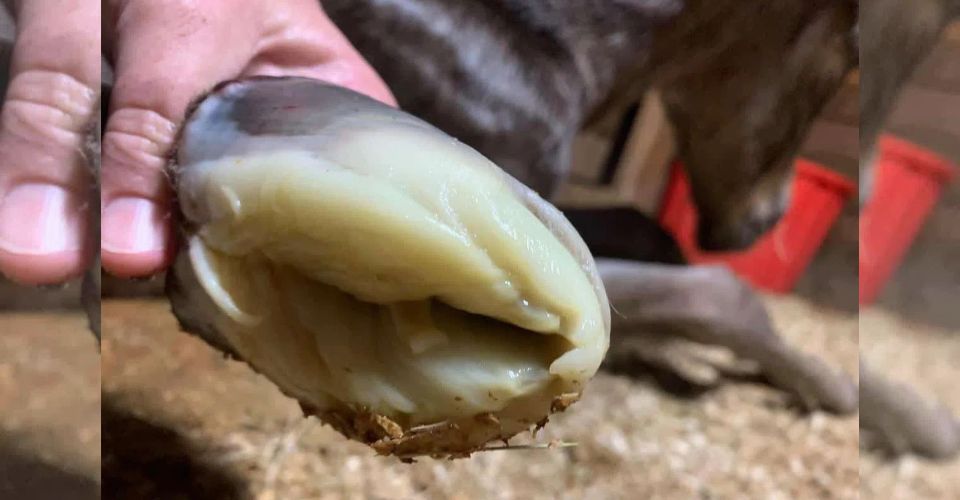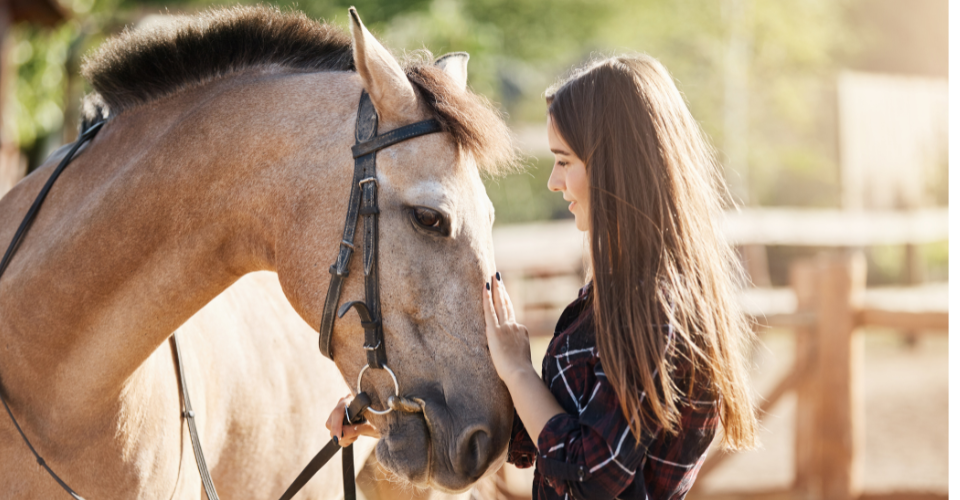We admire beauty and strength, and when the two attributes merge in one creature, it becomes hard to resist the temptation to own such a creature or just praise it. Equine enthusiasts face such scenarios often when they witness a number of horse breeds and the wide variety of majestic colors they are found in.
Like the Palomino and Cremello, the Blood Bay horse is such a stunning horse breed, whose remarkable reddish tint never fails to mesmerize onlookers. There is a lot to know about this beautiful horse breed – just hang on and let us gallop into the world of the Blood Bay horse!
What Is a Bay Horse?
Bay is one of the most common coat colors in horses ranging from reddish-brown to brown with dark coloration of the mane, tail, ears, and lower parts of the legs. The black parts, also known as point-blacks, are necessary for a horse to be classified as bay-colored. The point-blacks might further have white markings over them.
Bay color appears in horses due to the presence of the Agouti gene and a black base coat. Some famous shades of bay color include:
- Bay Pinto
- Blood Bay
- Copper Bay
- Golden Bay
- Mahogany Bay
- Sandy Bay
- Silver Bay
Also, note that the bay color is often confused with chestnut; however, both of them are not the same because despite being very brown, chestnut steeds do not have point-blacks on the mane, tail, ears, and legs.
Blood Bay Horse Is About Shade, Not Breed
Indeed, with dark red rich bay coats, Blood Bay horses are picturesque enough to be classified as a separate breed. However, it is not a separate breed but just a horse color pattern that comes in a variety of horse breeds.
Moreover, blood bay is just one of the many, but the best-known, shades of bay color. Any breed having such shade looks absolutely spectacular.
Did You Know?
Blood Bay shade is common in the Quarter Horse breed.

Blood Bay Horse Physical Characteristics
The physical characteristics of the blood-bay-colored horses depend upon the breed they belong to. You can expect the following in them:
Coat
The coat color of Blood Bay horses is distinct because of the presence of more strawberry roan or blood-red tincture in comparison to Bay horses with coats of other shades. Due to this striking difference, Blood Bay equines look fresher and shinier, giving off a more polished appearance than Bay horses of other, darker shades, especially in the sunlight. The red color, in fact, is so dominant that these horses appear purple or plum during the times of dusk.
The coat color may appear dark brown or reddish; nonetheless, it is not so dark to be classified as red. Furthermore, amazingly, despite being dark, it always appears to be very bright.
However, like the rest of the Bay steeds, their tails, manes, and legs are dark.
Size
Since Blood Bay horse is not a particular breed, it is difficult to tell their exact size. However, as horses stand tall about 13 to 17 hh on average, it can be safely said that the Blood Bay horse size lies somewhere in between this range.
Weight
It is even more difficult to predict the weight of Blood Bay horses as compared to their size because, firstly, as already discussed, Blood Bay horse is not a breed. Secondly, there exist different weights within the same breed of horses, much depending upon the feed, exercise, and activity level of any particular horse.
You can estimate it to be in the range of 800 to 1,200 pounds, as most of the horses fall within this range.
Blood Bay Horse Uses
The use of each Blood Bay horse depends entirely on his breed. For instance, if a Blood Bay horse belongs to the Thoroughbred breed, he will be mostly used for racing, showjumping, dressage, combined training, polo, and hunting foxes. On the other hand, the ones belonging to other breeds will have different uses.
Blood Bay Horse Diet
Blood Bay horses can live happily with grass and flakes of hay. However, like all other equines, having a bit of variety in this ‘general’ diet plan is certainly a thumbs up for them. Remember that horses’ digestive system is quite different from humans’, so before offering any human food to your horse, make sure that it is safe for them. The most loved and horse-safe fruits and veggies include strawberries, blueberries, apples, bananas, cucumbers, lettuce, asparagus, etc. Conversely, many human foods are poisonous to horses, such as potatoes, tomatoes, onions, garlic, etc.
Read: What Do Horses Eat?
Blood Bay Horse Health
Blood Bay horses are generally healthy, just like other Bay horses. However, they can develop health issues that are common to all equines. For example, they can get equine flu, laminitis, colic, gastric ulcer, arthritis, etc.
To make sure that a pet Blood Bay horse remains fit and healthy overall, the owners should plan vet visits for complete examination at least once every year. If their horse is older, say above 20 years of age, the visits should occur twice a year because diseases are more common at such an age.
Blood Bay Horse Facts

Here are some amazing facts about Blood Bay horses:
Blood Bay Horses Are Ordinary
Besides the striking coat color and appearance, there is nothing special about the Blood Bay horses. Though they might be more attractive than other horses, they are not superior to the latter in any other sense. Moreover, further superiority only depends upon the breed type.
Blood Bay Horses Are Not Common
Blood Bay horses cannot be found easily. As a matter of fact, on average, this shade can be found in one among 100 horses only. So given the rarity of the coat color, they can have a hefty price tag, and the expensive horse breeds featuring blood bay color would become even more expensive.
Blood Bay Horses Have Black Points
Blood Bay horses have black color on their ears, eyes, nose, legs, and muzzle. Besides, their mane and tail are also black.
Blood Bay and Sorrel Horses Are Not the Same
Sorrel horses have reddish coats but lack black color points. Nevertheless, they are a bit orangey in a tone, which Blood Bay horses are not – they are more reddish. Sorrel horses also lack black manes and tails.
Blood Bay Is the Second Darkest Shade in Bay Color
For being exceptionally dark, the Blood Bay color shade is believed to be the second darkest shade next to none other than Black Bay. One of the reasons why this shade appears so dark is the presence of black skin underneath the coat.





